By Wallace Wyss with Roy Smith
Somewhere it is written that all mid-engined sports cars have to be shaped like, well, sports cars.
Whoever wrote that is wrong.
The Renault R5 Turbo of the 1980s is an exception but what a delightful exception it is indeed. It is a hatchback that looks from a distance like a zillion other economy cars. Ho-hum, a suburban mommy’s car
Then you look close and see the huge flares at the rear and relatively wide tires for its size you realize this is an economy car with a Godzilla complex. The deception is like that scene from a lot of movies, where there’s this Marion the Librarian type, with dowdy clothes and hair up in a bun and horn rimmed glasses and when she meets Mr. Wonderful she shows up on their first date with her long hair down and a dress that reveals a stunning figure. You get the picture.
The car came about in the early 1980s, originally designed for rallying. In order to make the tooling pay off and qualify as a production car, a road version was produced and made available in limited numbers. It was never a legally homologated approved model in the U.S. but nonetheless one estimate is that as many as 250 were snuck into the U.S., some made legal and others just registered as Renault 5’s which were a legal model.
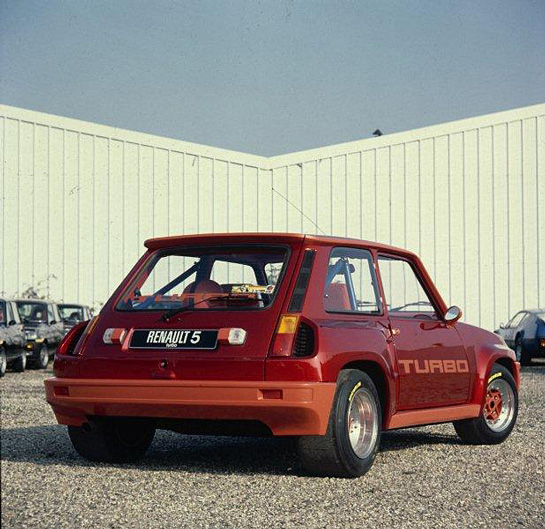
No more Mr. Nice Guy. The first Turbo Series 1 was an economy car with a Godzilla complex. Photo Renault.
There was actually a front-engined Renault 5 Turbo before that but it wasn’t so dramatic. Roy Smith, author of the Renault Alpine Trilogy (order here) told us that the front-engined Turbo was the simple Renault 5 body shell in France called an Alpine. “In Britain it was called a 5 Gordini it was a development of the carbureted model and was launched in 1980.”
It was when they decided to built a mid-engined car that the idea went from say, a .22 to a .45 caliber, to use a gun analogy.
Smith helped clarify the series of mid-engined Turbos built by Renault. The mid engine R5 T, Series 1 was a car created from the original Rally car created in 1978/79. Initially only a few were built. The Series 1 cars featured aluminum roof and doors (though some the last
Series 1 cars did have steel doors from early T2 cars as the production line changed). It was essentially a road car version of the Rally car. “In addition to the alloy roof,” said Smith, “the front hood and rear wings and in the case of my own car the rear door was of fiberglass and weighed in at 970 kilograms and had 160 bhp on tap. There were other differences in the cockpit, the seats, the dash, and the location of switches were all more ‘proto’ than production. In total around 1,600 of the Series 1 were built between 1980 and spring 1982.”
The Turbo 2 came along in the summer 1982 and was made up to 1986. The T2 is all steel with a “soft” interior. A production list in the French book, “Alpine Label Bleu” by Christian Descombes shows that 3,167 T2 cars were made in Dieppe on a production style line. The T2 was very much more of a road car with modifications made with a high production run in mind.
In both the T1 and T2, the engine was placed behind the driver in a body shell that began as a front engined Renault 5. The front shell is standard Renault 5 but from the cockpit back it’s all different and specially made. At first, the stock engine was rated with the turbocharger at 160 HP. The car was fast for its size, doing 0 to 60 mph in 6.7 seconds with a top speed of 126 mph. The pushrod engine featured an aluminum head with beautifully formed hemi combustion chambers. As the car grew, so did the horsepower: According to Smith, The type Cevennes 822 1397 cc produced 200 bhp, the type Tour de Corse 822 1397cc produced 240 bhp (7,000rpm) but 265 to 285 in group B rally trim. Finally, the type R5 Maxi 1597cc produced 350 bhp (6,500 rpm).
The first incarnation of the Turbo had some wild upholstery worthy of a French op artist but a later version had leather, offering some unusual colors such as an electric blue in combination with a bright orange. According to connoisseurs of the model the one to get is one of the first series cars with the aluminum panels and Berex-designed interior.
The wheels were small in diameter compared to today’s tall wheels. The fronts measure 14 3/8 inches in diameter. The rears are 15 3/8 inches. Originally they were designed for Michelin TRX radials and now these sizes are all but impossible to find as they are no longer produced. Many owners now use 15″ all round or 13″ front 15″ rear with modern sizes of tires, with Yokohamas being favored.
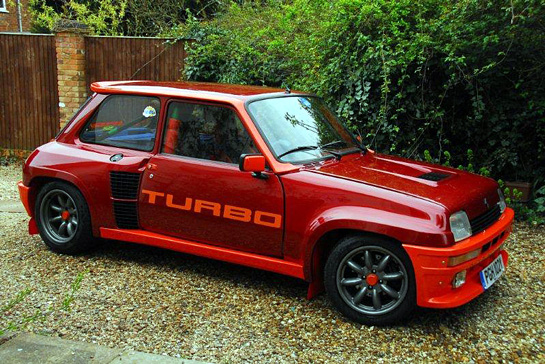
Roy Smith’s Turbo Series 1. The car was built as a chassis in right hand drive format as a costing exercise in 1980. It is a great car, blindingly fast on acceleration and very light. I do have the original 14 inch wheels but here the car is on 15s.
The Turbo’s plumbing was short and direct, which made for minimal lag, a benefit of Renault’s Formula One experience. But F1 engines are out in the open, while this one was under a carpeted cover behind the driver. Heat buildup and aging rubber hoses create a potential fire hazard. If you replace various hoses with braided metal lines you eliminate this danger. Heat shielding is also very important to keep intact as it’s there for a reason.
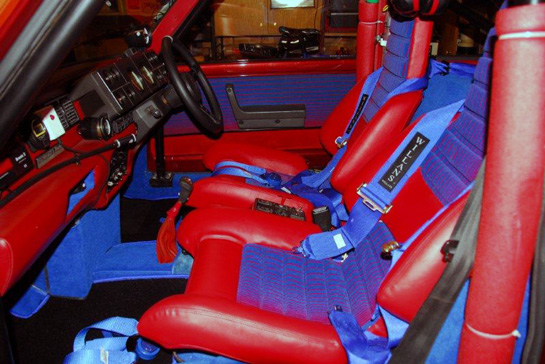
Wild indeed. The Turbo Series 1s often were equipped with very bright interiors. This is Roy Smith's.
You bought the car for its handling, and its bold looks. The weight distribution was roughly 40/60 weight distribution and it boasted unequal-length control arm suspension at all four corners, rack-and-pinion steering and non servo-ed four-wheel disc brakes so you felt everything directly which is exactly what a race driver wants. Those who were formerly used to front wheel drive couldn’t get over how direct the steering is and how quickly you can go into power oversteer.
In California these cars were in vogue for awhile when a company called Sun International in Manhattan Beach figured out how to make them legal. Another name mentioned in a search of sources is Centennial Motors, a dealer in Boulder, Colo. Renault, though didn’t want the legal responsibility of making “gray market cars” and tried to stop their dealers from selling parts for cars that went to America.
This driver remembers borrowing one from Jasjet Rarewala, an Indian-born mechanic who was legalizing one in California. He invited me to take it around the block for a spin and tell him what I thought of it. I first went around in a deserted industrial part at a normal speed and saw how well it steered. So, gaining confidence, I next went around the block hanging the rear end out. So far so good. Then I went around in a two wheel drift, hanging the back wheels out at about a 30-degree angle. Duck soup. Then I went around the corner in a four wheel drift. Still in control. The fifth time I went around spinning the car like a top at all four corners and still felt perfectly in control. That, the Lotus Esprit Turbo and the Lancia Stratos remain the high points of cars I’ve driven where I felt 100% mastery over the control at any speed, any angle.
They were expensive as gray market cars in California, listing for about $22,000. That compared to about what a Porsche 944 cost new but the march of time has been cruel to Porsche 944s which are down to $3,000 and Turbo 2 cars are at least $15,000 to $20,000 depending on condition with the earlier rarer Turbo 1 models a bit pricier.
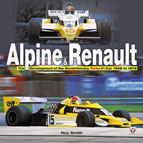
Good books on the subject: Dominique Pascals book “Renault 5 Turbo L’ecole du Groupe B” and a smaller book by the same author, “Renault 5 Turbo” published by EPA and la Renault 5 Turbo by Fredrerick L’Hospied, And don’t forget Smith’s “Alpine and Renault; The Development of the Revolutionary Turbo F1 Car” with a full chapter on these fascinating cars. (order here).
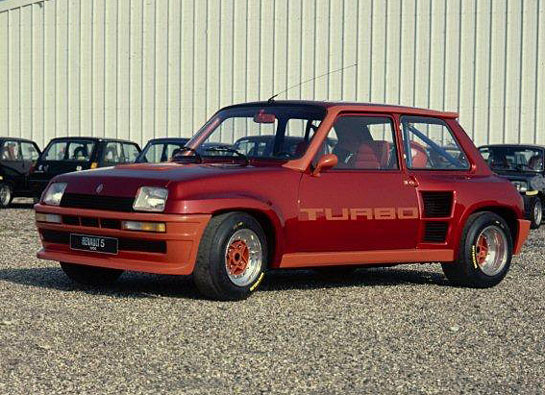
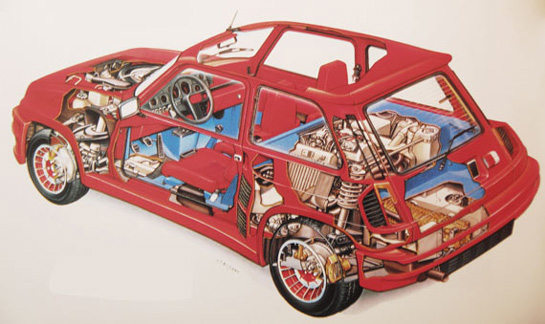
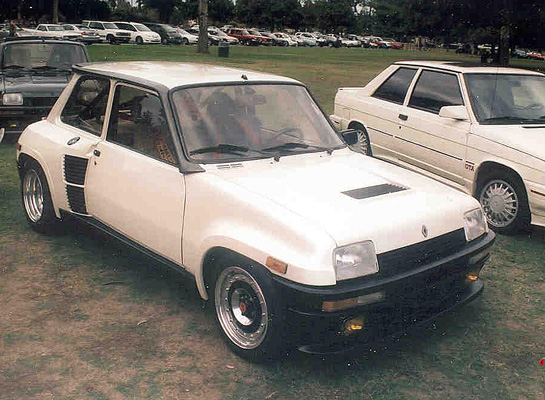
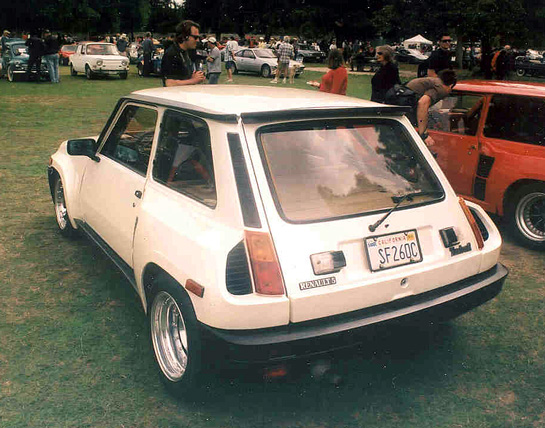
In the mid 1980s when I had a European car shop on the El Camino in Sunnyale,Ca., a friend stopped by with his R-5 Turbo. He insisted I drive it, an offer one cannot turn down. Drove onto the El Camino and made a U turn at Fair Oaks with a clear shot towards San Jose. “Get On It, Get On It” was the owner’s command. I nailed it and as I went by the BMW dealer we hit 100 mph in a 35 mph zone. If the cops had been there I would have first smoked their radar and then gone to jail. What a great car.
Thank you for running the photos of my personal ’85 R5Turbo 2.
I ordered this “Nacre” 822F in late 1984 from a dealer in Germany. I had it sent back to the Alpine/Renault Sport factory for a few changes, which included the FACTORY 15″ Gotti wheels (not “aftermarket”, but from the Renault Sport Catalog), ZF roller locked LSD, lowered tarmac ride height, “Coupe Turbo” dampers, quick ratio steering gear (yes, even quicker than the stock gear, with a smaller diameter Alpine steering wheel), “Devil” exhaust (Coup Turbo again), and “Coup Turbo” full alloy roll cage by Matter of Germany as used in the Coupe Turbo race series. In addition, a box with the “185 PS” kit (larger charge air cooler, shim for the waste gate to increase boost) was shipped along with the car for me to install when the car finally arrived in April of ’85.
While heat may have been a problem in some of the cars, mine, with over 30K miles on it, has all of its original hoses, and no leaks or heat damage. This is because I pay attention to the engine cooling fan installed in the right rear corner of the engine compartment. This little floor mounted fan and duct MUST BE WORKING, or the car can melt, or burst into flames. It runs when the engine is OFF, as there is no cooling air flow through the engine compartment when the car is stopped. Renault spend quite a bit of time working on the heat control in the engine compartment, and if everything works, the heat is not really a problem. While I do have a complete set or two of the soft hoses for the engine, I have not yet had to replace them. Everything component wise, seems to be doing fine.
Engine options included my 185 PS, using the larger charge air cooler, and an increase in boost. The 210 PS engine is quite a bit more modified, using a different fuel distributor, cylinder liners, pistons, exhaust header and ignition.
The factory had a huge number of options, from the 15″ A310 type wheels (8″ front, 10.5″ rear) of my car, to compound air/air/water charge air coolers. Turbos up to a huge Air Research TO4 were available, while the Maxis had very special variable geometry turbos. Roll cages of both alloy and steel were also available, as well as specialty such as the straight through “Devil” exhaust system. The straight through Devil was missing from my car when the pictures were taken as it was on its way to its bi-annual smog test, and had it’s US installed Cat fitted. It always passes without issues.
I imported the car myself, and the initial compliance was done by Bob’s Automotive. The EPA part was fine, but there were problems with the paperwork, and Renault made a very determined try to keep the cars from being approved in the US. It took new paperwork, and two years calling the NTSB three times a week, but the car was finally awarded plates, and shortly after that, the coveted California ARB door sticker for emission compliance and testing.
While some owners have opted for the 15″ wheels for tire availability, this has proven to be a cruel joke. Tires that actually fit the 10-11″ rear wheels are rare, being only the 285/40/15, a 23″ tall, foot wide tire that is hardly ever available. I was able, after a 3 year negotiation with producer Yokohama (Pirelli was the only other producer offer this size), to get them put back into production (after a 12 year hiatus) a couple of years ago, but those tires are gone. Though Yokohama has the tires on “re order status”, there is no indication as to when they may make more, if any. Not much in 15″ fits on those wide rear rims properly. The tires that do are WAY too tall for the little 1.4 liter to pull. The handling is also adversely affected as well.
Front tires are 195/50/15, and these are available from Yokohama in the “S Drive” series. They seem to work fine when paired with the old style AVS Intermediate 285s.
I don’t know of anyone running 13″ fronts and 15 or 16″ rears.
The original 245 mm and 265 mm TRX tires are available from Coker, so if the car has original style rims, tires are readily available here and in Europe. Note that these are specific METRIC TRX wheels, and not “14 inch”.
The 13″ wheels are really the ones that the car was designed for. These used the very special “Coup Turbo” tires, designed for the “Coup Turbo” race series that followed the F1 circus in the early 80s. The sizes are 210/530/13 and 280/580/13. Again, the problem is with the rear tires, and the 9″ wide rims, with a F1 aspect ration of 58. This also gives a 23″ tall tire.
Fortunately, we can use the Avon 500 series tires for the Caterhams. They are about .25″ short in the radius, but they work beautifully. For the best R5 Turbo handling experience, this is the best setup.
The car’s value was uderstated. The last one to go at auction (A steel Turbo 2 with a door sticker) went for around $40,000, while others have fetched $45,000. I have not seen prices on prime early Turbos, but they are much rarer, and more valuable. Actually, the cars are worth about 30% more in Europe than here in the US.
Here, the car’s value is higher if it has the CARB door sticker, making it legal in CA. Passing smog is not difficult, and all of the bits necessary to do that (evap system, lambda computer, O2 sensor, cat) are available, and not difficult to install.
However, if the car doesn’t have the sticker, there are hoops to jump through. That is why there are quite a few cars around now that have been off the books for the last 20 years turning up here and there. If you live in CA, be prepared to bring the car up to EPA standards. No one will bother you about the old DOT requirements. EPA is easy, if you know how to do it.
Another unexpected benefit for Turbo owners is that many of the parts are again being made available by parts houses in France. Even hard to find trim bits, as well as just about everything mechanical, and some of the old Renault Sport rally parts. Even Bilstein is offering dampers, which I have fitted to my car. Excellent!
I am into my 26th year with the car, and it never ceases to amaze me with its 1G cornering ability and strong midrange acceleration. It was initially designed for tarmac rallys, and this makes it perfect for the Corsica/Rally France sort of roads we have here in the local Santa Monica mountains.
There was an interesting difference between the 5 Gordini and the turbo version. For one thing, the turbo version was a good 5 km/h slower than the normal aspirated version.
I also heard rumors that little engine pushed as much as 700hp. No idea how long it could do it with its design.
I saw as much as 16 Turbo 2 at last year’s Best Of France & Italy.
A friend of mine has one and a 1600 A110. He says he just can’t part from them. I understand, I would too.
Thanks for this great article.
Now what about Ventury, Bonnet-Djet, and all those ectera? I guess etceterini is etcetera for the French off the beaten path cars?
Back in the early 80’s, I owned R5Turbo1, number 714 for a while. It was a shockingly fast car… but you did have to drive with the turbo and short wheelbase in mind at all times. At a stop light, it was a slug through the crosswalk then as you got the boost up a little, it pulled incredibly strong. It easily got to 125 MPH but didn’t want to go much faster. The aluminum doors had to be shut carefully to not bend the window frame. The short wheelbase meant that if you didn’t know how to drive, you’d get in trouble… but if you did have the touch, it was an incrdible thrill ride. I had quite a few shocked passengers. What great memories!
I had taken interest in the R-5 in the mid 80s. In September, 1985, my wife and I packed up and relocated in Paris for a job I had taken.
By the end of January we had seen enough of the inner périphérique (ring road, or city loop) Paris and the Metro. It was time to expand our interest, so having our own auto was in order.
Off I went to the Renault dealer. By this time there were rumors that they would build no more R-5s. The dealer confirmed this and told that a German dealer had just taken delivery of what might be the last production run. So, after a complicated money wiring sequence, my extremely bright red R-5 was shipped back to Paris for my pick-up. The transition from taking the Metro to pick-up your very own pocket rocket will not be forgotten.
I had owned a Saab Turbo prior, so I was experienced in the ways of “turbo-lag,” etc.
It was almost all “lag” and no turbo until the tach registered 2500 r’s. Say goodbye to my Southern California drag racing tendencies. But from 3000 north you were in for the street ride of your life.
The only other auto thrill I would compare it to was in my 20s, when riding in my friends fender-less, running board-less, Model-A roadster with 3 factory mounted two-barrels atop a Pontiac V-8. The whole car twisted and flopped about under full throttle.
After mastering the slow start, I mastered entering and exiting the Etoile (aka: Arc de Triomphe) under power. Admittedly, I’m a pretty Ugly American under power.
By end of our stay we headed south to attend the Cannes Film Festival. Lovely experience. Twenty years earlier I had worked in Madrid for the summer and always wanted to go to Rome….. but didn’t manage it. So it was off to Rome. Stop and go lights seemed to have an almost reverse meaning in Rome. You do stop when the light turns red, but then you always crawl out into the intersection as the car next to you tries to get a nose ahead of you. Within 30 seconds, if there appears to be little to no cross traffic, it’s red-light-be-damned and a bonsai run to the next light.
The contrast of French driving manners and Italian is large. Also, the only awareness I had of driving what I thought was a cool car in Paris was dashed when a pedestrian spanked my hood in passing, loudly exclaiming “CAPITALIST.”
In Rome at a light, amidst some fairly good looking Italian autos, a group of 20-somethings men bolted into the street, surrounding the R-5, loudly exclaiming their praise. They loved it. So did I.
We turned north through Switzerland, and Germany. Awe, how lovely are those autobahns… the flat nosed, puffed out wheel wells, short wheel based Frenchy, topped out at 125mph.
Spent a month in Sweden, then off to Norway…. just in time to have the Chernobyl nuclear cloud darken our days.
Los Angeles, California, home sweet home. Trying to import this “grey-market” exotic offered a master course in government bullshit.
Things had changed drastically since I first oogled R-5s in L.A. barely a year earlier. R-5s were not listed as importable, so I was temporarily driving on a time limited $50k entry bond. The DOT asked for my “crash test.” Say what???
They wanted to know that my R-5 would pass their standard crash test. Perseverance is the name of the government game…… and pass I finally did (with Sun International doing the smog conversion).
Trouble with living in Malibu Canyon (actually the very serpentine Cold Canyon), you don’t want to drive anything less than the R-5 on a daly basis, so the R-5s odometer climbed, and climbed…… until Johan, our son, was born.
And baby makes three! That’s a killer for a wonderfully tight little two-seater. Time to grow-up again…… and I’m still trying.
Do I wish I still had it? Yes, and no. I’d probably wear it out in another year. Cool cars don’t hold-up well when the odometer eclipses the 100,000 mark a few times.
Sold it to Danish fellow who took it back to Denmark. I’ve subsequently worked in Copenhagen, and always had my eye open for that sweet little red devil… to no avail.